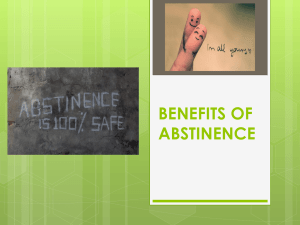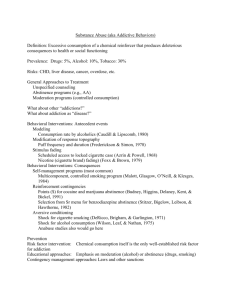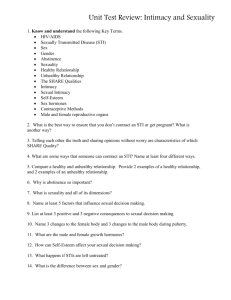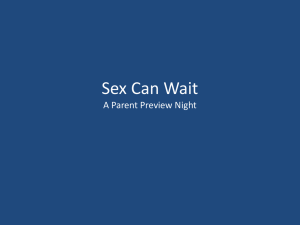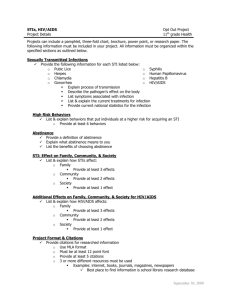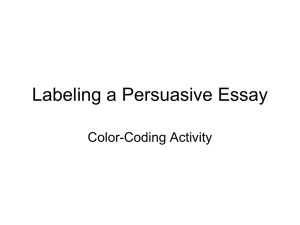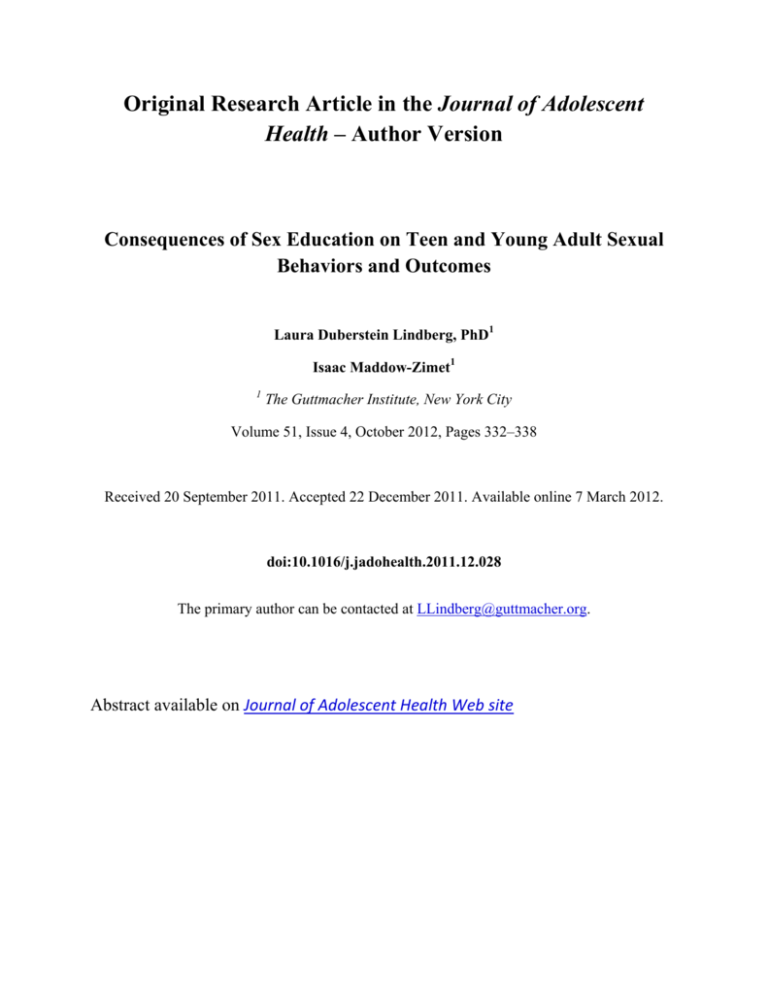
Original Research Article in the Journal of Adolescent
Health – Author Version
Consequences of Sex Education on Teen and Young Adult Sexual
Behaviors and Outcomes
Laura Duberstein Lindberg, PhD1
Isaac Maddow-Zimet1
1
The Guttmacher Institute, New York City
Volume 51, Issue 4, October 2012, Pages 332–338
Received 20 September 2011. Accepted 22 December 2011. Available online 7 March 2012.
doi:10.1016/j.jadohealth.2011.12.028
The primary author can be contacted at LLindberg@guttmacher.org.
Abstract available on Journal of Adolescent Health Web site
Implications and Contributions: This study expands on previous research on the association
of formal sex education with sexual health and behaviors, and finds that formal sex education
that includes instruction about both waiting to have sex and methods of birth control can improve
the health and well-being of adolescents and young adults.
Abstract
Purpose
This study examined whether formal sex education is associated with sexual health behaviors
and outcomes using recent nationally representative survey data.
Methods
Data used were from 4,691 male and female individuals aged 15-24 from the 2006-08 National
Survey of Family Growth. Weighted bivariate and multivariate analyses were conducted by
gender, estimating the associations of sex education by type (only abstinence, abstinence and
birth control, or neither) before first sexual intercourse, and sexual behaviors and outcomes.
Results
Receipt of sex education, regardless of type, was associated with delays in first sex for both
genders, as compared to receiving no sex education. Respondents receiving instruction about
abstinence and birth control were significantly more likely at first sex to use any contraception
(odds ratio [OR] = 1.73, females; OR=1.91, males) or a condom (OR=1.69, females; OR=1.90,
males), and less likely to have an age-discrepant partner (OR=.67, females; OR=.48, males).
Receipt of only abstinence education was not statistically distinguishable in most models from
receipt of either both or neither topics. Among female subjects, condom use at first sex was
significantly more likely among those receiving instruction in both topics as compared with only
abstinence education. The associations between sex education and all longer-term outcomes were
mediated by older age at first sex.
Conclusions
Sex education about abstinence and birth control was associated with healthier sexual behaviors
and outcomes as compared to no instruction. The protective influence of sex education is not
limited to if or when to have sex, but extend to issues of contraception, partner selection, and
reproductive health outcomes.
Keywords: Contraception, Teen pregnancy, Sex education, Abstinence, Age at sexual initiation,
Sexual behavior
Introduction
Formal sex education—curriculum based programs both in and out of school— is a key strategy
for promoting safer sexual behaviors for adolescents and young adults [1]. Between fiscal years
1997 and 2008, the federal government provided more than $1.5 billion to education programs
focused solely on abstinence until marriage. Federal guidance prohibited programs using these
funds to discuss contraceptive methods, except to emphasize their failure rates [2]. Paralleling
this funding stream, from 1995 to 2002 there were significant increases in the proportion of
teenagers receiving instruction only about abstinence (males, 9% to 24%; females, 8% to 21%)
and decreases in the proportion receiving instruction about both abstinence and birth control
methods (males, 65% to 59%; females, 84% to 65%) [3]. Data from the 2006-08 National Survey
of Family Growth (NSFG) indicate that these patterns recently remained stable, leaving many
adolescents without formal instruction about birth control (males, 38%; females, 30%) whereas
most adolescents received abstinence education (males, 81%; females 87%) [4,5].
These changes in the content of formal sex education occurred without scientific
evidence supporting the effectiveness of abstinence-only programs [6]. Although one recent
study on younger teens identified some positive impacts of abstinence-only education that
promoted delaying the onset of sex [7], it leaves intact the body of evidence in several systematic
reviews concluding that abstinence-until-marriage programs are ineffective in delaying sexual
debut or reducing sexual risk behaviors among sexually experienced teens [8,9]. In sharp
contrast, evaluations of comprehensive sex education programs find greater efficacy; in Kirby’s
most recent review, two-thirds of 48 comprehensive programs teaching both abstinence and the
use of birth control had positive behavioral effects [10].
A handful of studies have examined the influence of sex education at the population
level. Three analyses of the 2002 NSFG examined the association between sex education prior to
first intercourse and select measures of adolescent sexual behaviors. Kohler et al estimated that
receipt of comprehensive sex education was marginally associated with less likelihood of vaginal
intercourse and a significantly reduced likelihood of teen pregnancy, but found no association
between abstinence-only education and these outcomes [11]. A second study, which did not
distinguish between abstinence and comprehensive sex education, found that receipt of sex
education was associated with delayed onset of sexual activity among both genders, and
increased likelihood of birth control use at first sex among male, but not female, adolescents
[12]. Another study of female adolescents found that contraceptive use at first sex did not vary
among those receiving abstinence or comprehensive sex education, but did not contrast these
findings with no instruction [13].
We used data from the 2006-08 NSFG to extend and refine prior research in a number of
important ways. We examined the association between receipt of formal sex education by type
and key behaviors during a more recent time period. The 2006-08 NSFG measured sex
education among respondents aged 15-24 years, instead of only adolescents, permitting
examination of sex education’s longer-term impacts.
Additionally, we examined a wider range
of outcomes, including timing of first sex, contraceptive use, prevention of pregnancy and
sexually transmitted infections (STIs), as well as the development of healthy relationships.
Methods
Data
The data analyzed were from the 2006-08 NSFG, a nationally representative household
survey of U.S. male and female persons aged 15-44 years. The survey used a multi-stage,
stratified, clustered sampling frame to collect interviews continuously from June 2006 to
December 2008. Detailed survey methodology has been described elsewhere [14]. Information
about the receipt of formal reproductive health education was collected in face-to-face interviews
from respondents aged 15-24 years. An audio, computer-assisted, self-administered interview
contained items on sensitive topics, including pregnancy and STIs.
Measures
Formal Instruction. Respondents aged 15-24 years were asked whether they had received formal
instruction before age 18 years on “how to say no to sex,” or “methods of birth control” and the
grade of first receipt of each. We added five years to the reported grade to estimate age at first
receipt [15]. Comparing age at instruction and age at first sex, we calculated whether instruction
was received before first vaginal intercourse.
We combined these responses into a categorical variable for sex education received
before first sex: “how to say no” only, both “how to say no” and birth control (Ab+BC), or
neither topic. Past studies using NSFG data have categorized receipt of instruction about both
“how to say no” and birth control methods as comprehensive sex education [3,11,13]. However,
this no longer seems appropriate, given the recognition that abstinence programs may highlight
the ineffectiveness of contraceptive methods. As we do not have information about the content or
tone of instruction about birth control methods, we cannot label these as comprehensive
instruction that would teach about birth control methods as a means to prevent pregnancy.
Dependent Variables. Twelve dependent variables related to young people’s sexual and
reproductive health (SRH) behaviors and outcomes were examined. For each measure we created
a dichotomous indicator (0 = no, 1 = yes). Measures referring to first vaginal sexual intercourse
include timing of first sex, contraceptive use at first sex and condom use at first sex. Partnership
measures at first sex include with a romantic partner (vs. a casual partner), with an agediscrepant partner (age difference of 3 years or more in either direction), or unwanted first sex
(respondents agreed with the statement, "I really didn't want it to happen at the time"). Lifetime
and current SRH indicators measured at the time of the interview included having had six or
more sexual partners, ever been (or gotten a partner) pregnant, STI treatment in the past 12
months, and contraceptive use at last sex (any effective method or condom use). The first three
incorporated audio, computer-assisted, self-administered interview reports.
Sociodemographic Variables. Each model included measures of age at interview (integer ages:
15-24 years), race/ethnicity, poverty level, mother’s education, living arrangements at age 14
years, frequency of attendance at religious services at age 14 years, and community type.
Models referring to the time of the interview included measures of current union status.
Analytical Approach
The analytical sample was limited to respondents aged 15-24 years at the time of the interview.
We excluded respondents who reported age of first intercourse before age 10 years (n=12).
Following the approach of Kohler et al, we also excluded respondents reporting only receiving
formal birth control instruction without mentioning abstinence (n=366), as well as 14 cases with
missing information on sex education. After these exclusions, the total sample comprised 2,505
female and 2,186 male individuals aged 15-24 years.
All analyses were conducted separately by gender. Analyses were weighted and use the
svy command prefix in Stata 11.1 (StataCorp, College Station, TX) to adjust for the complex
survey design of the NSFG. Bivariate analyses using χ2 tests examined associations between
receipt of sex education and 1) the sociodemographic covariates and 2) the SRH behaviors and
outcomes. Kaplan-Meir survival curves, stratified by receipt of formal sex education, were used
to examine the bivariate association between type of sex education and the timing of the
transition to first sex.
We estimated multivariate discrete-time logistic hazard rate models of the association
between type of sex education and the transition to first sexual intercourse before age 20 years,
incorporating censored cases. Separate observations, or person-years, were created for each year
that a respondent was at risk of having first sex; data were censored for respondents who have
not had sex or not reached the completed age by the time of interview. Time was measured as a
series of single-year categorical variables indicating respondent’s age at each person-year,
allowing the risk of initiation of sexual activity to vary with age. Socio-demographic variables
were included as fixed covariates.
Next, we estimated multivariate logistic regression models of the association between
formal sex education received before first intercourse and the other SRH behaviors and
outcomes. Models estimating characteristics of first intercourse were limited to sexually
experienced respondents with nonmissing data on the timing of sex education (n= 1,647 females,
n=1,360 males). Models estimating lifetime and current measures were limited to never-married
sexually experienced respondents with nonmissing data (n=1,383 females, n=1,242 males); for
ever-married respondents, the health and well-being implications were unclear. In all models,
type of sex education was included as a categorical variable. For each outcome, we estimated
two nested models, the first including all socio-demographic covariates and the second
controlling for age at first sex. Controlling for both age at interview and age at first sex also
controls for duration of time since first sex.
Results
Bivariate
Two-thirds of sexually experienced females and 55% of sexually experienced males received
Ab+BC prior to first vaginal sex (Table 1). About one in five respondents reported receiving
only abstinence education before first sex. Sixteen percent of sexually experienced female and
24 % of sexually experienced male respondents reported not receiving instruction in either topic
before first sex. Receipt of sex education varied significantly by most of the covariates
examined, with receipt of neither topic more common among respondents who were black or
Hispanic, who were living in a poorer household, whose mothers had lower education, who were
not living with two parents at age 14 (females only), and who attended religious services less
frequently (females only). For both genders, healthier behaviors and outcomes were generally
positively associated with receipt of sex education of either type, whereas riskier behaviors were
more likely among respondents not receiving instruction in neither topic (Table 2).
Figures 1A and 1B illustrate the failure curves of onset of first vaginal sex, before age 20
years, by receipt of sex education. For both genders, the timing of first vaginal sex had
significantly earlier onset among those reporting no sex education. The curves for receiving only
abstinence or Ab+BC were severely overlapping and indistinguishable on the graph. Before
turning age 20, 86% of female and 88% of male respondents without sex education had vaginal
sex; in contrast, among those receiving only abstinence or Ab+ BC, 77-78% had sex before age
20 years.
Multivariate
Initiation of vaginal sex. After adjusting for other socio-demographic covariates of engaging in
vaginal intercourse, and adjusting for censoring, receipt of either only abstinence or Ab+BC
education (as compared to not receiving instruction on either topic) significantly delayed the
transition to first vaginal sex (Table 3). The magnitude of the associations was greater for male
than for female respondents. However, for both genders, there were no significant differences in
the timing of first sex between those receiving only abstinence or Ab+BC instruction.
Contraceptive use at first sex. In Model 1, female respondents reporting receipt of Ab+BC were
significantly more likely to have used any contraception (adjusted odds ratio [ORadj]=2.01) or a
condom (ORadj =1.62) at first sexual intercourse than those not receiving sex education. There
was no significant association with receipt of only abstinence education. Among males, in model
1, receipt of only abstinence education and Ab+BC were each significantly associated with an
increase in the likelihood of using any contraception or a condom at first sex. However, after
controlling for age at first sex in model 2, only receipt of Ab+BC was significantly associated
with increased contraceptive use and condom use at first sex for both male and female
respondents. Compared to female respondents receiving Ab+BC, those reporting receipt of only
abstinence education were significantly less likely to use a condom at first sex in both model 1
and model 2; among male respondents, there were no significant differences in contraceptive or
condom use between the two types of instruction.
First partnership characteristics. In the first set of models (model 1), receipt of Ab+BC was
significantly associated with a reduced likelihood of having an age-discrepant partner among
females as compared to either receipt of only abstinence or no instruction. Among males in
model 1, compared with no instruction, receipt of Ab+BC (ORadj =.36) or only abstinence
(ORadj=.45) significantly reduced the likelihood of having an age-discrepant partner; there was
no significant difference between these two categories of instruction. In both model 1 and model
2, receipt of Ab+BC reduced the likelihood of reporting that first sex was unwanted by more
than half among female respondents; the association was negative among male respondents, but
not statistically significant at conventional levels (p=.06). In model 1, male respondents
receiving either only abstinence (ORadj =1.59) or Ab+BC (ORadj =1.85) were significantly more
likely to have a romantic partner at first sex; there was no significant association among female
respondents. In model 2, the associations for male respondents were no longer significant.
Lifetime and Recent SRH Outcomes and Behaviors. In model 1 of Table 4, Ab+BC was
associated with reductions in the likelihood of having 6 or more partners for both genders;
receipt of only abstinence education was negatively associated only among male respondents.
After controlling for age at first sex in model 2, none of these associations remained statistically
significant. Similarly, among male respondents, in model 1, Ab+BC was significantly associated
with ever making a partner pregnant (ORadj =.49), condom use at last sex (ORadj =1.86), and
recent STI treatment (ORadj =.44). However, after controlling for age at first sex in model 2, none
of these relationships were statistically significant. In contrast, among female respondents,
models 1 and 2 showed no significant associations between sex education and pregnancy, STI
treatment or contraceptive or condom use at last sex. The two sets of models indicate that
Ab+BC indirectly influenced recent behaviors among male respondents through delaying first
sex, but had no significant association with recent behaviors for females. In none of the models
was there a significant difference between receipt of only abstinence and Ab+BC.
Discussion
In this study, receipt of formal sex education before first sex, particularly that including
instruction about both delaying sex and birth control methods, was associated with a range of
healthier outcomes among adolescents and young adults as compared with not receiving
instruction in either topic. Receipt of Ab+BC was associated with delayed onset of first sex,
greater use of contraception or condoms at first sex and healthier partnerships at first sex.
Associations between Ab+BC and longer term outcomes were only indirect, operating through
older age at first sex, particularly among male respondents, reducing their likelihood of having
gotten a partner pregnant, multiple partnerships, and recent STI treatment, and increasing the
likelihood of condom use at most recent sex.
For the nearly 20% of adolescents and young adults who reported receipt of only
abstinence education, we found few clear significant associations between this instruction and
SRH behaviors and outcomes. Receipt of only abstinence education, without additional
instruction about birth control, was associated with delayed onset of vaginal sex. Across the
other behaviors and outcomes examined, receipt of only abstinence education rarely had a direct
association with the SRH measures. Additionally, in most models receipt of only abstinence
education was statistically indistinguishable from the each of the other categories of sex
education (Ab+BC or neither topic). However, females receiving Ab+BC were significantly
more likely than those receiving only abstinence education to use a condom at first sex,
suggesting that more comprehensive sex education better promoted condom use.
We believe that the lack of many significant differences between receipt of only
abstinence and Ab+BC derive at least in part from our inability to identify details of the
instruction about birth control measured in the NSFG. Reported birth control instruction may
promote the use of contraception or only discuss failure rates and ineffectiveness as required by
federal abstinence-until-marriage legislation. We expect that reports of receipt of BC instruction
fall into both camps, diminishing the “real world” differences between our analytical categories.
Future efforts to measure receipt of sex education must better distinguish the tone and content of
birth control instruction.
Contrary to some critics of formal sex education, we found no evidence that receipt of
either type of sex education was associated with earlier onset of sex, greater risk taking, or
poorer SRH outcomes. Even when the estimated associations were not statistically significant at
conventional levels, the direction of association was consistently towards less healthy SRH
behaviors and outcomes among those who did not receive instruction in either abstinence or birth
control before first sex. As both receipt of Ab+BC or only abstinence education significantly
increased age at first sex , it appears that talking with adolescents about sex – before they first
have sex—seems to be what is important, regardless of the specific subject matter.
This study is among the first to demonstrate associations between sex education and
selection of partners. Unwanted first sex and age-discrepant partnerships are associated with
poorer reproductive health outcomes, including STIs, pregnancy and less contraceptive use [1619]. Further research should work to identify and strengthen the mechanisms underlying the
links between sex education and first partnerships, whether through decision making and
selection or less exposure to riskier situations, such as alcohol or drug use before sex.
Our efforts to examine longer-time effects of sex education revealed patterns of indirect
associations, as the association between sex education and longer-term outcomes was
substantially moderated by age at first sex. In general we found that male respondents were
more likely than female respondents to have an indirect association between the sex education
they received before first sex and longer-term outcomes or behaviors. This likely reflects that
fact that for male adolescents and young adults, there are fewer opportunities to supplement their
initial formal sex education, since they are more likely to be out of school and less likely to have
contact with the health care system. Together this speaks to the need for sex education beyond
initial classroom instruction as well as linkages to reproductive health care services. Health care
providers, who are a highly trusted source of information among this age group, can supplement
and refresh previous formal instruction [20]. Increasing access is imperative, especially for
young men, who are substantially less likely to talk with a health care provider about sexual
health issues.
The significant socio-demographic differentials in the receipt of sex education before first
sex are troubling. Nearly one-third of young men of color did not receive instruction on either
abstinence or birth control methods before first sex. Among both males and females, receipt of
Ab+BC was less likely among those who were from a lower-income group, had lower maternal
education, or were black or Hispanic; these demographic groups have poorer SRH outcomes,
including higher rates of STIs and teen pregnancy, highlighting the unmet need for formal
instruction in sex education.
The findings reported here face a number of limitations. The measures of receipt of
instruction are limited, in that they only report if any instruction occurred, but tell us nothing
about other important aspects of the education, such as its quantity, quality or specific content.
Additionally, these self-reported measures of reproductive health instruction reflect adolescents’
recall of such instruction. Finally, observational studies such as this always face challenges in
ascribing causality. Our results are strengthened by the use of multivariate models which control
for a range of socio-demographic characteristics temporally distant from the outcomes which
may be correlated with both sex education and the outcomes under study. Additionally, our
investigation of multiple outcome measures offers validation of general patterns. [21]
This study demonstrated that formal sex education which includes instruction about both
waiting to have sex and methods of birth control can improve the health and well-being of
adolescents and young adults. The protective influence of sex education is not limited to the
questions of if or when to have sex, but extend to issues of partner selection, contraceptive use,
and reproductive health outcomes. Creating access to medically accurate comprehensive sex
education, and reducing socio-demographic disparities in its receipt, should remain a primary
goal for improving the well-being of teens and young adults. At the same time, recognizing that
maintaining SRH is an ongoing process, access to relevant information, services and support
should remain available over the course of a lifetime.
Acknowledgements
The authors thank Lawrence Finer for technical assistance and reviewing several drafts of
the article. The research on which this article is based was supported by The California Wellness
Foundation. The conclusions and opinions expressed here are those of the authors and not
necessarily those of the funder.
Reference List
1. U.S. Department of Health and Human Services. Healthy People 2010: Understanding and
Improving Health. Washington, DC: U.S. Department of Health and Human Services,
Government Printing Office, 2000.
2. HHS, Health Resources and Services Administration, Maternal and Child Health Bureau,
Special Projects of Regional and National Significance (SPRANS) Community-Based
Abstinence Education Project Grants, HRSA-04-077, Catalog of Federal Domestic
Assistance (CFDA) No. 93.110, FY 2004 Program Guidance Competing Announcement, 5.
3. Lindberg LD, Santelli JS, Singh S. Changes in formal sex education: 1995-2002. Perspect
Sex Reprod Health 2006;38:182-189.
4. Lindberg, L. & Maddow-Zimet, I. (2011). Monitoring trends in sex education and
information. Journal of Adolescent Health 48[2], S105-S106.
5. Martinez G, Abma J and Copen C. Educating Teenagers About Sex in the United States.
Hyattsville, MD: Department of Health and Human Services, 2010.
6. Trenholm C, Devaney B, Fortson K, Quay L, Wheeler J, Clark M. Impacts of Four Title V,
Section 510 Abstinence Education Programs: Final Report. Princeton, NJ: Mathematica
Policy Research, 2007.
7. Jemmott JB, III, Jemmott LS, Fong GT. Efficacy of a theory-based abstinence-only
intervention over 24 months: a randomized controlled trial with young adolescents. Arch
Pediatr Adolesc Med 2010;164:152-159.
8. Bennett SE, Assefi NP. School-based teenage pregnancy prevention programs: a systematic
review of randomized controlled trials. J Adolesc Health 2005;36:72-81.
9. Underhill K, Montgomery P, Operario D. Sexual abstinence only programmes to prevent
HIV infection in high income countries: systematic review. BMJ 2007;335:248.
10. Kirby DB. The impact of abstinence and comprehensive sex and STD/HIV education
programs on adolescent sexual behavior. Sex Res and Social Policy 2008;5:18-27.
11. Kohler PK, Manhart LE, Lafferty WE. Abstinence-only and comprehensive sex education
and the initiation of sexual activity and teen pregnancy. J Adolesc Health 2008;42:344-351.
12. Mueller TE, Gavin LE, Kulkarni A. The association between sex education and youth's
engagement in sexual intercourse, age at first intercourse, and birth control use at first sex.
J Adolesc Health 2008;42:89-96.
13. Isley MM, Edelman A, Kaneshiro B, et al. Sex education and contraceptive use at coital
debut in the United States: results from Cycle 6 of the National Survey of Family Growth.
Contraception 2010;82:236-242.
14. Lepkowski JM, Mosher WD, Davis KE, Groves RM, VanHoewyk J. The 2006–2010
National Survey of Family Growth: Sample Design and Analysis of a Continuous Survey .
Hyattsville, MD: National Center for Health Statistics, 2010.
15. Lindberg LD, Ku L, Sonenstein F. Adolescents' reports of reproductive health education,
1988 and 1995. Fam Plann Perspect 2000;32:220-226.
16. Senn TE, Carey, MP. Age of partner at first adolescent intercourse and adult sexual risk
behavior among women. J Women's Health 2011; 20:61-66.
17. Manlove J, Ryan S, Franzetta K. Patterns of contraceptive use within teenagers' first sexual
relationships. Perspect Sex Reprod Health 2003;35: 246-255.
18. DiClemente RJ, Wingood GM, Crosby RA, et al. Sexual risk behaviors associated with
having older sex partners: a study of black adolescent females. Sex Transm Dis 2002;29:
20-24.
19. Darroch JE, Landry DJ, Oslak S. Age differences between sexual partners in the United
States. Fam Plann Perspect 1999;31:160-167.
20. Kaye K, Suellentrop K, Sloup C. The Fog Zone: How Misperceptions, Magical Thinking,
and Ambivalence Put Young Adults at Risk for Unplanned Pregnancy. Washington, DC:
The National Campaign to Prevent Teen and Unplanned Pregnancy, 2009.
21. Lindberg LD, Orr M. Neighborhood-level influences on young men's sexual and
reproductive health behaviors. Am J Public Health 2011;101:271-274.
Table 1
Receipt of sex education before first sex by topic, among sexually experienced females and males aged 15-24 years, by selected characteristics (weighted),
2006-2008 National Survey of Family Growth
Characteristic
All sexually experienced
Age at interview
Age 15-17 years
Age 18-19 years
Age 20-24 years
Race/ethnicity
Hispanic
Non-Hispanic white
Females
Males
Type of sex education
Type of sex education
Abstinence
and birth
control (%)
66
Only
abstinence
(%)
18
Neither
(%)
16
59
69
66
25
17
17
16
13
16
62
68
15
19
23
13
61
74
20
19
19
7
64
62
70
19
16
19
17
22
11
58
66
70
17
16
20
69
62
Non-Hispanic black
Other
Household poverty status
<100%
100-199%
>=200%
Mother's education
< High School
High School or GED
Some college or more
Living arrangements at age 14 years
Both biological/adoptive parents
Other
Religious attendance at age 14 years
Never
Sometimes
Often
Community Type
Suburban
Urban
Rural
GED = general educational development
p
Abstinence
and birth
control (%)
55
Only
abstinence
(%)
21
Neither
(%)
24
p
.41
52
46
58
24
29
18
25
25
24
.09
47
60
21
21
32
19
44
72
22
12
34
16
.05
42
50
62
18
27
20
40
23
18
<.01
26
17
10
<.01
39
51
63
25
24
18
36
25
19
.01
19
17
12
21
.01
57
51
20
22
23
27
.43
69
64
66
11
18
21
20
18
13
.05
61
58
51
12
19
25
28
23
23
.14
68
63
67
17
20
18
15
17
15
.76
57
55
51
22
17
26
21
29
22
.21
.08
<.01
Table 2
Percent of females and males aged 15-24 years engaging in select SRH behaviors and outcomes, by type of sex education before first sex,
2006-2008 National survey of Family Growth (NSFG)
SRH behaviors and outcomes
Females
Males
Type of Sex Education
Abstinence
and birth
Only
Total
control
abstinence Neither
(%)
(%)
(%)
(%)
Type of Sex Education
p
First vaginal intercoursea
Used contraception
Used condom
Sex unwanted
Age-discrepant partner
Romantic partner
75.7
65.8
8.7
30.0
75.8
79.7
70.3
6.9
26.3
78.3
73.7
58.3
7.9
34.6
71.5
60.8
55.4
17.6
40.6
70.1
<.01
<.01
<.01
Lifetime and current outcomesb
Ever pregnant
Six or more partners
Recent STD treatment
34.7
26.1
8.7
31.5
22.9
7.1
28.6
25.1
11.2
54.8
40.7
12.6
<.01
<.01
Behaviors at last sexb
Used contraception
Used condom
74.5
48.6
77.3
51.8
69.9
50.1
67.9
33.8
SRH = sexual and reproductive health; STI = sexually transmitted infection.
a
among respondents who had vaginal intercourse.
b
among never-married respondents who had vaginal intercourse.
Abstinence
and birth
Only
Total
control
abstinence Neither
(%)
(%)
(%)
(%)
p
82.0
77.5
5.6
13.0
57.3
85.8
80.7
3.2
9.9
62.7
85.6
79.9
5.5
11.3
58.7
69.9
68.3
11.0
21.8
43.6
<.01
<.01
16.6
34.5
2.9
20.9
32.6
4.4
34.4
57.2
6.7
<.01
<.01
.12
21.9
39.7
4.2
.16
.03
85.8
64.9
88.1
68.8
87.8
68.6
80.0
55.1
.12
.09
.01
.11
.01
.01
<.01
.08
Table 3
Results of multivariate logistic regressions of associations between characteristics of first sex and type of sex education, by gender, in
females and males aged 15-24 years, 2006-2008 National Survey of Family Growth (NSFG)a
Characteristic
Females
Sex education before first sex
Abstinence and birth
control
Only abstinence
(Neither)
Transition
to first sex
before age
20 years
Any effective
contraceptive
usebc
Age at first sex (linear)
Sex unwantedb
Age discrepant
partnerb
Romantic
partnerb
OR
Model
1
OR
Model
2
OR
Model
1
OR
Model
2
OR
Model
1
OR
Model
2
OR
Model
1
OR
Model
2
OR
Model
1
OR
Model
2
OR
0.54**
0.62*
2.01**
1.36
1.73*
1.19
1.62*
0.92^
1.69*
0.95^
0.40**
0.50
0.46*
0.54
0.64*
1.06^ 0.67*
1.11
1.41
0.94
1.17
0.80
Age at first sex (linear)
Males
Sex education before first sex
Abstinence and birth
control
Only Abstinence
(Neither)
Condom useb
1.15**
0.41**
0.38**
2.60**
2.46**
1.91*
1.90
1.22*
0.97
2.13**
1.88*
1.90*
1.69
0.86**
0.39
0.59
1.06
0.34
0.51
1.18
0.96
0.36**
0.45*
0.48*
0.60
0.78**
1.17**
1.85**
1.59*
1.41
1.24
1.22**
OR = odds ratio.
a
All models also control for age at interview, race/ethnicity, household poverty status, mother's education, community type, living arrangements at age
14 years, and religious attendance at age 14 years.
b
Among respondents who had vaginal intercourse.
For the purposes of this analysis, withdrawal was not included as a contraceptive method.
* p<=.05.
**p<=.01.
^ p<=.05 between "abstinence and birth control" and "only abstinence."
c
Table 4
Results of multivariate logistic regression of associations between lifetime SRH outcomes and type of sex education, by gender, in
unmarried sexually experienced females and males aged 15-24 years, 2006-2008 National Survey of Family Growtha
Lifetime SRH outcomes
Six or more
partners
Model 1
OR
Ever pregnant
Any effective
contraceptive use
at last sexb
Condom use at
last sex
STI treatment in
last 12 months
Model 2
OR
Model 1
OR
Model 2
OR
Model 1
OR
Model 2
OR
Model 1
OR
Model
2
OR
Model
1
OR
Model
2
OR
0.88
1.06
0.64
0.52
1.00
0.70
0.99
0.63
0.88
0.59
1.49
1.39
1.18
1.21
0.80
1.54
1.17
2.02
Females
Sex education before first sex
Abstinence and birth control
Only abstinence
(Neither)
0.47**
0.72
Age at first sex (linear)
Males
Sex education before first sex
Abstinence and birth control
Only abstinence
(Neither)
Age at first sex (linear)
0.55**
0.32**
0.35**
0.60
0.54
0.62**
0.64**
0.49*
0.53
0.86
0.82
1.11
1.31
1.90
0.71**
a
1.16
1.71
1.10
All models also control for cohabitation status, age at interview, race/ethnicity, household poverty
status, mother's education, region, residence at age 14 years, and religious attendance at age 14 years.
b
For the purposes of this analysis, withdrawal was not included as a contraceptive method.
* p<=.05
**p<=.01
1.29**
1.86*
1.74
1.58
1.57
1.14*
0.72**
0.44*
0.54
0.73
0.77
0.70**
Figure 1 The failure curves of onset of first sex, before age 20 years, by receipt of sex education, among (A) females aged 15‐24 years and (B) males aged 15‐24 years.

